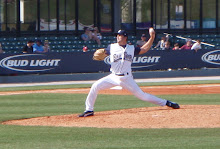Greetings to all out there in Less Is More land. Today we'll be discussing some basic knowledge stuff that might be able to help some people identify exactly what kind of pitch they throw and what they want to throw. This post will discuss the many types of breaking pitches, namely the cutter, slider, slurve, and curve. We are discussing these pitches in this order because of the amount of perceived break or movement in each pitch.
1. Cutter - This pitch made famous by Mariano Rivera is the most similar to a fastball. Generally, it is thrown only a few mphs slower than the fastball. The pitch normally has no downward movement. Instead, it "cuts" glove side (depending on which hand you throw with). The movement is linear (left to right) and is great for "hand-cuffing" hitters who think they are swing at a fastball. Mariano is notorious for starting this pitch off the outside corner and bring it back for strike 3 or starting it on the inside corner and sawing off the hitter.
2. Slider - This pitch is the first of our family that introduces any kind of downward movement. The slider must still come out of the pitcher's hand flat as a fastball. However, when that pitch gets to the plate, its movement is short and quick, down and in. If we think about its movement according the face of a clock, the slider will move from 2 o clock to 7 o clock. I usually think of John Smoltz or CC Sabathia when I think of pitchers who have fantastic sliders. As a left handed pitcher, I happen to think the left on left slider is one of the hardest pitches to hit in the game. (Think of Randy Johnson versus...any left ever). The reason this pitch is so effective is, like a cutter, it comes out of the hand looking so much like a fastball. The difference, however, is that its sharp downard movement contributes to a high amount of swinging strikes. It is my favorite of the four.
3. Slurve - This bigger breaking ball is a type of "hybrid" pitch that has more lateral movement than a slider but is thrown harder and with more sweeping across action than a curve ball. Genreally, this pitch is "turned" earlier in the release point to allow for more perceived movement to the hitter. It is tricky because it can somes look like a fastball and produce swinging strikes or be slightly "loopier" and freeze the hitter who thinks the pitch is out of the zone until it is too late. Less pitchers in the MLB throw this particular pitch, however, many different breaking pitches can be described as a slurve because of its differing movement patterns.
4. Curve - The curve is ultimately the most easily recognizable pitch of the four. The movement is the "biggest" of them all and generall moves straight up and down toward the hitter. This is where the terminology " 12 to 6 curve ball comes from. Big Leaguers such has Josh Beckett and Barry Zito utilize the traditional curve ball to make a living. The curve is tricky because of the size of the pitch's movement. The pitch is usually atleast 10 mphs slower than a fastball and the large amount of downward movement makes it difficult to time up and make solid contact.
So I hope this clears up any confusion there may have been over the four main types of breaking balls out there.
Also, if there are any questions you would like answered, please comment here and I'll be happy to get them up on the blog.
Until Next Time!!
Tuesday, January 19, 2010
How Many Different Breaking Balls Are There?
Labels:
baseball,
Breaking Balls,
curve,
cutter,
slider,
slurve,
Williamsburg,
WISC
Subscribe to:
Post Comments (Atom)

No comments:
Post a Comment